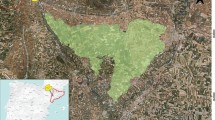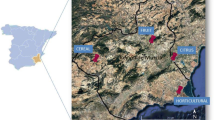Abstract
The agricultural activities practice often demands an intensive application of fertilizers. Phosphate and nitrogen fertilizers are the most employed in the corn growing areas of the central Mexico highlands. The first ones presents an uranium content ranging from 50 to 200 mg. kg−1 depending on the origin of the phosphate rock used in its production. It is crucial to analyze the rainwater, surface water, soil water at several depths, groundwater and soil to determine the simultaneous behavior of phosphate, nitrate and uranium, and their leaching in a specific agricultural land. Uranium concentration, 16 mg. kg−1, in the soil water was higher than that in the surface water and groundwater. The different concentrations are due to an unequal uranium distribution in the environment. The phosphate concentration, 37.4 mg. kg−1, diminished throughout the profile of the soil due to a sorption–precipitation process. The nitrates were leached toward groundwater after the application of fertilizers, but the nitrate concentration in it did not exceed the limit for drinking water.
Similar content being viewed by others
References
APHA, AWWA, WEF (1995). Standard Methods for the examination water and wastewater, 19th edn, Washington, D.C.: APHA, AWWA & WEF.
Barisic, D., Lulic, S., & Miletic, P. (1992). Radium and uranium in phosphate fertilizers and their impact on the radioactivity of waters. Water Resource, 26, 607–611.
Bayliss, P., Sabina, S.A., Anderson, & R.y Cesbrón F. (1986). A minerals power diffraction file, databook, internacional centre for diffraction. Editorial Staff U.S.A. Joint Committee on Powder Diffraction Standards (JCPDS).
Custodio, E., & Llamas, M.R. (1983). Hidrología subterránea editorial omega (2359 p.). Barcelona España.
Deutsch, W.J. (1997). Groundwater geochemistry, fundamentals and applications to contamination (221 p). New York, USA: Lewis Publishers.
Diario Oficial de la Federación (DOF), 13 de Diciembre (1989). Criterios Ecológicos de Calidad del Agua. México
Domenico, P.A., & Schwartz, F.W. (1998). Physical and chemical hydrogeology, (2nd ed.) New York USA: John Wiley & Sons. Inc.
Drever J.I. (1988). The geochemistry of natural waters (Chap- ter 15, 437 p). Englewood Cliffs, New Jersey: Prentice Hall.
Eghball, B., Binford, G.D., & Baltensperger, D.D. (1996). Phosphorus movement and adsorption in a soil receiving long term manure and fertilizer application. Journal of Environment Quality, 25, 1339–1343.
Esteller, M.V., & Andreu, J.M. (2005). Antropic effects on hydrochemical characteristics of the Valle de Toluca aquifer (Central Mexico). Hydrogeology Journal, 13, 378–390.
Fetter C.W. (1993). Contaminant Hydrogelogy (Chapter 6, 243 p). New York USA: Macmillan Publishing Company.
Freeze, R.A., & Cherry, J.A. (1979). Groundwater englenwood cliffs. N.J. USA: Prentice-Hall, Inc.
Geng, Q.Z., Girard, G., & Ledoux, E. (1996). Modeling nitrogen cycle and nitrate transfer in regional hydrogeologic systems. Groundwater, 34, 293–304.
Gerritsen, R.G. (1993). Prediction of travel times of phosphate in soils at a disposal site for wastewater. Water Resource, 27, 263–267.
Goldberg, S., & Sposito, G. (1984). Uranium solution at low temperature with applications to sedimentary deposits. Geochimica et Cosmochimica Acta, 42, 547–569.
Hall, D.W. (1992). Effects of nutrient management on nitrate levels in groundwater near Epharata Pennsylvania. Groundwater, 30, 720–730.
He, Z.L., Wilson, M.J., Campell, C.O., Edwards, A.C., & Chapman, S.J. (1995). Distribution of phosphorus in soil aggregate fractions and its significance with regard to phosphorus transport in agricultural runoff. Water, Air and Soil Pollution, 83, 69–84.
Jabro, J.D., Toth, J.D., Dou, Z., Fox, R.H., & Fritton, D.D. (1996). Evaluation of nitrogen versión of LEACHM for predicting nitrate leaching. Soil Science, 160, 209–217.
Journel, A.G. (1989). Fundamentals of geostatistics in five lessons, short course geol (Ser., Vol. 8). Washington, D.C.: AGU.
Kohler, M., Curtis, G.P., & Kent, D.B. (1996). Experimental investigation and modeling of uranium (VI) transport under variable chemical conditions. Water Resources Research, 32, 3539–3551.
Linsalata, P. (1989). Exposure to long-lived members of the uranium and thorium decay chains. Radiation Physics and Chemistry, 34, 241–250.
Plummer, L.N., Prestemon, E.C., & Parkhurst, D.L. (1991). An interactive Code NETPATH for modeling net geochemical reactions along a flow path. U.S. Geological Survey Water Resources Investigations, Reports, 91–4078, 227 p.
Puigdomenech, I. (2004). Make Equilibrium Diagrams Using Sophisticated Algorithms (MEDUSA) program. Inorganic Chemistry Department, Royal Institute of Technology, 100 44, Stockholm, Sweden. http://web.telia.com/~u15651596/.
Pulido, J.S., Aguilar, A.G., & Vázquez, A. (1992). Química de suelos. México: Universidad Autónoma de Chapingo.
Romero, G.E.T., Solache, M., Iturbe, J.L., & Ordoñez, E. (1995). Uranium in phosphate rock and derivates. Journal of Radioanalytical Nuclear Chemistry, 189, 301– 306.
Rothbaum, H.P., McGaveston, D.A., Wall, T., Johston, A., & Mattingly, G. (1979). Uranium accumulation in soils from long continued applications of superphosphate. Journal of Soil Science, 30, 147–153.
Sharpley, A.N., Smith, S.J., & Nancy, J.W. (1987). Environmental impact of agricultural nitrogen and phosphorus use. Journal of Agriculture Food and Chemisry, 35, 812–817.
Taylor, S.R., & McClennan, S.M. (1985). The Continental Crust: its composition and evolution. Blackwell Scientific.
USEPA. (1996). National primary drinking water regulations for radionuclides. Proposed rules. Washington D.C. 570 9-71-700. Report.
Vighi, M., Soprani, S., Puzzarini, P., & Menghi, G. (1991). Water quality phosphorus loads from selected watersheds in the drainage area of the northern adriatic sea. Journal of Environment Quality, 20, 439–444.
World Health Organization, OMS (1993). Guidelines for drinking water quality. Ginebra: WHO Publications.
Zielinski, R.A., Asher, B.S., Meier, A.L., Johnson, C.A., & Szabo, B.J. (1997). Natural or fertilizer derived uranium in irrigation drainage: a case study in southeasters Colorado, USA. Applied Geochemistry, 12, 9–21.
Author information
Authors and Affiliations
Corresponding author
Rights and permissions
About this article
Cite this article
Guzmán, E.T.R., Regil, E.O., gutiérrez, L.R.R. et al. Contamination of corn growing areas due to intensive fertilization in the high plane of mexico. Water Air Soil Pollut 175, 77–98 (2006). https://doi.org/10.1007/s11270-006-9114-1
Received:
Accepted:
Published:
Issue Date:
DOI: https://doi.org/10.1007/s11270-006-9114-1




